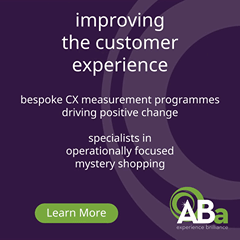Retail Management: The Importance of Customer Experiences in Retail
Not too long ago, the success of a retail business depended heavily on a customer experience produced solely by a store’s physical features and touchpoints.
The stock, customer service standards, shop floor layout, and other traits would all go a long way in determining the reputation of a brand, and how well it performed in a given niche.
With the shift towards eCommerce that’s occurred over the last two decades, accelerated greatly by the COVID-19 pandemic, traditional retail businesses are under increased pressure to provide an experience that’s competitive, convenient, and consistently pleasant across all interactions.
In this post, we’ll take a closer look at the importance of customer experience in retail, and the steps that retail businesses can take to improve theirs.Why Customer Experience is Important
Though the ecommerce revolution has allowed people to buy the products they want with a few taps of their phones, the in-person retail experience still has an important place in the minds of modern consumers, and many ecommerce brands are taking steps to fulfil this demand. Here’s some of the core ways that a positive ecommerce experience can impact the broader success of a business.
It Can Foster a More Recognisable Brand Identity
One of the best ways to build recognition and loyalty for brick-and-mortar retail stores is by creating a stand-out customer experience, whether through high customer service standards, a logical shop floor layout, or otherwise.
Like your products, your pricing, and the tone of voice in your marketing materials, your retail customer experience is a core element of your brand that will determine the way people view and interact with your business.
By crafting a customer experience that delights everyone who comes into your store, you’ll be investing in a steady growth in brand loyalty over time, and a dependable base of revenue stemming from local shoppers. With a great customer experience producing loyal customers, you’ll also be able to stimulate word-of-mouth marketing, a powerful source of growth for any retail business.
It Helps You Meet Consumer Expectations with Personalisation
Making a point to improve customer experiences can also help retail brands to meet the constantly-growing expectations of all retail brands, both online and offline.
Research by McKinsey shows that some 72% of shoppers expect businesses to provide experiences tailored to them as individuals, and the retail brands that take this trend onboard will have a much greater chance of success now and in the near future.
With modern ecommerce platforms offering greater and greater methods for personalising online experiences, traditional brick-and-mortar shops must rise to the occasion by providing a personal touch in all their in-person shopping experiences, transforming their business models to meet the expectations of modern customers.
It Provides a Human Touch That Customers Are Looking For
While technology progresses to automate person-to-person experiences in shopping more and more, many customers are still seeking human contact wherever they shop for products. Even when interacting with businesses online, 69% of consumers prefer talking to human agents when interacting with customer service departments, which speaks to the huge influence that face-to-face interaction still has in the minds of modern shoppers.
When operating a traditional retail store, you’re in a unique position to provide customers with the human touch they’re looking for, and craft a customer experience that will satisfy them more than any chatbot ever could.
The way you achieve this will vary depending on the type of store you’re running, your customer base, and various other factors. However, the potential to generate a more appealing and more well-defined brand identity through enhanced customer experience is a universal constant across all retail businesses.
How to Improve the Customer Experience in your Retail Store
Now that you have an understanding of just how important customer experiences can be in retail, here’s some of the most effective ways for retail businesses to enhance their in-store customer experience.
Get a Customer’s Perspective with Mystery Shopper Programs
Market research, online advertising analysis, and similar initiatives can all give you a pretty good idea of what your customers want from your store. However, for the most reliable and direct feedback on your retail customer experience, you’ll need to go straight to the source.
Mystery shopper schemes can be hugely advantageous for retailers looking to improve their customer experience, as participants join these programs specifically to give direct, impartial feedback on their interactions with your brand.
The responses you receive can give you powerful insights into many key aspects of your customer experience, such as product displays, promotions, and checkout or returns processes. You can even look into the performance of your staff, and hone in on issues in customer service that you may not have been aware of before.
By running these programs, and breaking down the data through a mystery shopper app, you’ll be able to harvest and action recommendations straight from the horse’s mouth, tailoring your in-store experience to the tastes of the people who matter most: your customers!
Train your Sales Associates to be More Than Sales Associates
Though technological retail solutions can go a long way towards crafting a more positive in-store experience for your customers, it’s important not to lose sight of one of the most important influences on your customer experience: your staff.
In today’s competitive retail arena, it’s no longer enough to make sure your staff are fully trained on your store policies, your products, and how to sell them. In all hiring and training initiatives, retailers must be able to develop staff who are more than salespeople trying to shift as much stock as possible.
Depending on your store’s unique specialism, you should aim to train your shop floor staff to present themselves more as product experts, consultants on the kinds of issues that your products solve, or even casual acquaintances to the people your store attracts.
By actively upgrading the relationship between your staff and your customers, and helping customers to see them as more than just people trying to sell them something, you’ll take one of the most important steps towards creating a shopping environment that customers love to be in.
Allow Customers to Experience Products Hands-On
Hands-on product experiences come with the territory for certain kinds of stores, for example clothing shops. However, if all your products are hidden in boxes on the shelves, there may be a better way to give your customers an idea of exactly how your products are going to fit into their day to day lives.
Giving your customers the chance to actually experience your products, rather than just look at them, will not only make for a more memorable retail experience, but can also give your brick-and-mortar shop a tangible edge over ecommerce shopping.
There’s many ways you can do this depending on the kinds of products you stock, but you don’t have to look far to find all kinds of great inspiration. Apple stores famously allow customers to try out their display models in order to decide whether or not their phones and tablets are right for them. An increasing number of golf shops have set up permanent simulators so that shoppers can have a few swings of a club before they buy it. Toy stores commonly leave out their products in a designated play area where kids can have a go.
Though there may not be practical hands-on experiences for every kind of store, by thinking outside the box and brainstorming ways you can provide a more experiential store visit, you’ll provide a more unique customer experience that will delight and interest your local audience.
Ensure your Online and Offline Experiences Work Together Seamlessly
While it’s certainly important to consider the in-store retail experience separately than your ecommerce touchpoints, modern consumers are used to interacting with a brand via several different channels in a typical buyer journey, and like your close competitors, you need to ensure your online and offline touchpoints are working seamlessly whenever your customers interact with your brand.
One of the best ways to do this is to invest in a well-oiled click-and-collect system, where your customers can pay for a product through your site or another online channel, and then pick up their order at a physical location. This will not only make the shopping experience more convenient for your customers, but will also attract more foot traffic to your stores, improving the chances that people will buy additional items after having a look around your displays.
You might also want to try a reverse take on this, by setting up devices in your stores that your customers can use to browse your website. This can be especially useful if you have multiple branches and can’t stock everything in one store, as it will inform your customers on the full extent of your range, and help to stimulate future ecommerce business.
Omnichannel experiences are quickly becoming a standard across ecommerce and traditional retail. Making it a priority at your stores will not only enhance the customer experience, but will ensure your brand stays in-line with rapidly changing industry trends.
Final Thoughts…
We hope this guide to improving the customer experience in retail has been helpful as you develop your business and find new ways to surprise and delight your customers.
With so much competition and higher consumer standards than ever, creating great customer experiences can be tough, but if you make it a priority for your brand, the effect on your bottom line can be huge!














